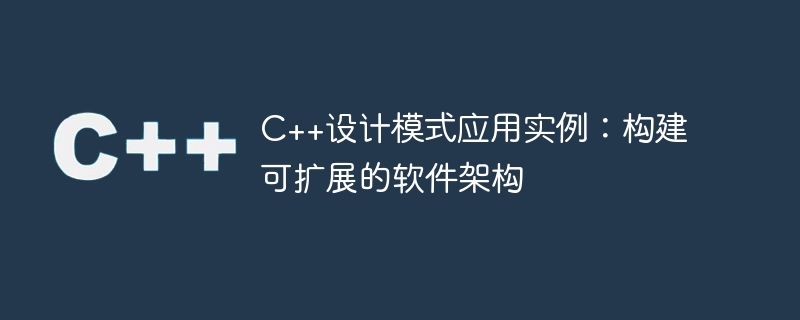

C Design Pattern Application Example: Building a Scalable Software Architecture
Introduction:
As the scale of software systems continues to grow, the scalability of software architecture become particularly important. A good software architecture can meet changes in system requirements, reduce dependence on and modification of existing code, and provide development efficiency and code reusability. C design pattern has become an important tool for building scalable software architecture due to its flexibility and scalability. This article takes the factory pattern, observer pattern and strategy pattern as examples to analyze their application in actual projects and demonstrate the value of C design patterns in building scalable software architecture.
The factory pattern decouples customer code from the creation process of specific products by encapsulating the creation process of objects. In software architecture, the factory pattern can be used to build scalable product creation mechanisms. Suppose we are developing an audio processing application that needs to support the decoding and playback of different types of audio files (such as WAV, MP3, FLAC, etc.). We can define an abstract audio decoder interface and declare the decoding method in the interface. Then, for different types of audio files, create corresponding specific decoder classes and implement decoding methods. Finally, we can create an audio decoder factory class to return corresponding specific decoder objects according to different types of audio files. Through the factory pattern, we can easily extend new audio file types by simply creating a new concrete decoder class and registering it in the factory without modifying the existing code.
In large software systems, communication and collaboration between different modules is an important issue. The observer pattern can be used to build a loosely coupled event notification mechanism to achieve efficient collaboration between modules. Suppose we are developing an e-commerce system and need to implement a series of operations after successful order payment, such as notifying the warehouse to ship, sending emails to users, etc. We can use the observer pattern to use the order payment success event as an observer, and the modules that subscribe to shipping events and email sending events as observers. When a successful payment event occurs, the observer will notify all observers to perform corresponding operations. Through the observer pattern, we can easily add new observers and update the notification logic of the observed without modifying the existing code.
In software systems, the selection and replacement of specific algorithms is often an issue that needs to be considered. The strategy pattern can be used to build scalable algorithm strategies and implement dynamic selection and replacement of algorithms. Suppose we are developing an image processing library that needs to support multiple filter algorithms, such as grayscale, blur, sharpening, etc. We can encapsulate each filter algorithm as a strategy class and define an abstract strategy interface, which declares methods for processing images. Then, we can use a strategy object in the image processing library to achieve different filter effects by setting different strategy classes. Through the strategy pattern, we can easily add new filter algorithms by creating a new strategy class and injecting it into the strategy object without modifying the existing code.
Conclusion:
C design patterns have important value in building scalable software architecture. Through the application examples of factory pattern, observer pattern and strategy pattern, we can see the flexibility and scalability of design patterns, which can isolate and encapsulate code changes and improve the maintainability and scalability of software systems. In actual projects, the rational use of design patterns can help developers build efficient, flexible and scalable software architecture, adapt to changes in demand and improve development efficiency. Therefore, for C developers, being familiar with design patterns and being able to use them flexibly is an important part of improving programming and design capabilities.
The above is the detailed content of C++ design pattern application examples: building scalable software architecture. For more information, please follow other related articles on the PHP Chinese website!




